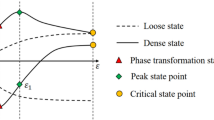Abstract
The study is devoted to the strength and deformation behavior of fine-grained sandstone. A series of triaxial compression tests were conducted on rock samples under various confining pressures (3, 5, 10, 15, and 20 MPa) in the laboratory. The experimental results showed that the nonlinear behavior and plastic deformation of the sandstone are prominent during loading process. The peak strength of the sandstone can be enhanced with the increase of the confining pressure. The initial yield stresses σy are approximately 87.2%, 80.2%, 62.1%, 75.2%, and 83.8% of the peak strengths σ p , respectively. The shear failure is predominated failure mode under different confining pressures. Based on experimental results, an elastoplastic model is proposed using a linear yield function in p-q plane, as well as a non-associated plastic potential function. Furthermore, the numerical formulations of a return mapping algorithm for constitutive model implementation are introduced in this work. The numerical results agree well with the experimental data, which show that this model is able to describe the elastoplastic behavior of the sandstone under triaxial compression.










Similar content being viewed by others
References
Cai M, Kaiser PK, Tasaka Y, Maejima T, Morioka H, Minami M (2004) Generalized crack initiation and crack damage stress thresholds of brittle rock masses near underground excavations. Int J Rock Mech Mining Sci 41:833–847
Chen CS, Liu YC (2007) A methodology for evaluation and classification of rock mass quality on tunnel engineering. Tunn Underground Space Technol 22:377–387
Clausen J, Damkilde L, Andersen L (2007) An efficient return algorithm for non-associated plasticity with linear yield criteria in principal stress space. Comput Struct 85:1795–1807
Dahou A, Shao JF, Bederiat M (1995) Experimental and numerical investigations on transient creep of porous chalk. Mech Mater 21:147–158
Grima MA, Babuška R (1999) Fuzzy model for the prediction of unconfined compressive strength of rock samples. Int J Rock Mech Mining Sci 36:339–349
Grueschow E, Rudnicki JW (2005) Elliptic yield cap constitutive modeling for high porosity sandstone. Int J Solids Struct 42:4574–4587
Huang J, Griffiths DV (2008) Observations on return mapping algorithms for piecewise linear yield criteria. Int J Geomech 8:253–265
Jeng FS, Weng MC, Huang TH, Lin ML (2002) Deformational characteristics of weak sandstone and impact to tunnel deformation. Tunn Underground Space Technol 17:263–274
Liu L, Xu WY, Zhao LY, Zhu QZ, Wang RB (2016) An Experimental and Numerical Investigation of the Mechanical Behavior of Granite Gneiss Under Compression Rock Mechanics & Rock Engineering:1–8
Martin C (1994) The progressive fracture of lac du bonnet granite. Int J Rock Mech Mining Sci Geomech Abstracts 31:643–659
Martin CD (1997) Seventeenth Canadian geotechnical colloquium: the effect of cohesion l. Can Geotech J 34:698–725
Øren PE, Bakke S (2003) Reconstruction of Berea sandstone and pore-scale modeling of wettability effects. J Pet Sci Eng 39:177–199
Pietruszczak S, Jiang J, Mirza FA (1988) An elastoplastic constitutive model for concrete. Int J Solids Struct 24:705–722
Shao JF, Zhu QZ, Su K (2003) Modeling of creep in rock materials in terms of material degradation. Comput Geotech 30:549–555
Simo JC (1992) Algorithms for static and dynamic multiplicative plasticity that preserve the classical return mapping schemes of the infinitesimal theory. Comput Methods Appl Mech Eng 99:61–112
Simo JC (1998) Numerical analysis and simulation of plasticity handbook of numerical analysis 6:183–499
Simo JC, Hughes TJR (1998) Computational inelasticity. Springer
Simo JC, Ortiz M (1985) A unified approach to finite deformation elastoplastic analysis based on the use of hyperelastic constitutive equations. Comput Methods Appl Mech Eng 49:221–245
Tsai LS, Hsieh YM, Weng MC, Huang TH, Jeng FS (2008) Time-dependent deformation behaviors of weak sandstones. Int J Rock Mech Mining Sci 45:144–154
Ulusay R, Hudson JA (2007) The complete ISRM suggested methods for rock characterization, testing and monitoring: 1974–2006. Int Soc Rock Mech, Commission Test Methods
Vermeer PA (1984) Non-associated plasticity for soils, concrete and rock. Springer, Netherlands
Wasantha PLP, Ranjith PG, Zhao J, Shao SS, Permata G (2015) Strain rate effect on the mechanical behaviour of sandstones with different grain sizes. Rock Mech Rock Eng 48:1883–1895
Weng MC, Jeng FS, Huang TH, Lin ML (2005) Characterizing the deformation behavior of tertiary sandstone. Int J Rock Mech Mining Sci 42:388–401
Xie SY, Shao JF (2006) Elastoplastic deformation of a porous rock and water interaction. Int J Plast 22:2195–2225
Yang SQ, Jing HW (2013) Evaluation on strength and deformation behavior of red sandstone under simple and complex loading paths. Eng Geol 164:1–17
Yang SQ, Jing HW, Wang SY (2012) Experimental investigation on the strength, deformability, failure behavior and acoustic emission locations of red sandstone under Triaxial compression. Rock Mech Rock Eng 45:583–606
Zhang JC, Xu WY, Wang HL, Wang RB, Meng QX, Du SW (2016) A coupled elastoplastic damage model for brittle rocks and its application in modelling underground excavation. Int J Rock Mech Mining Sci 84:130–141
Zhang Y, Shao JF, Xu WY, Zhao HB, Wang W (2015) Experimental and numerical investigations on strength and deformation behavior of Cataclastic sandstone. Rock Mech Rock Eng 48:1083–1096
Zhu QZ, Zhao LY, Shao JF (2016) Analytical and numerical analysis of frictional damage in quasi brittle materials. J Mech Phys Solids 92:137–163
Zorlu K, Gokceoglu C, Ocakoglu F, Nefeslioglu HA, Acikalin S (2008) Prediction of uniaxial compressive strength of sandstones using petrography-based models. Eng Geol 96:141–158
Acknowledgements
This work presented in this paper was financially supported by the National Natural Science Foundation of China (Grant Nos. 51479049, 11672343).
Author information
Authors and Affiliations
Corresponding author
Rights and permissions
About this article
Cite this article
Wang, S., Xu, W., Jia, C. et al. Mechanical behavior of fine-grained sandstone in triaxial compression and elastoplastic modeling by return mapping algorithms. Bull Eng Geol Environ 77, 1689–1699 (2018). https://doi.org/10.1007/s10064-017-1094-4
Received:
Accepted:
Published:
Issue Date:
DOI: https://doi.org/10.1007/s10064-017-1094-4




